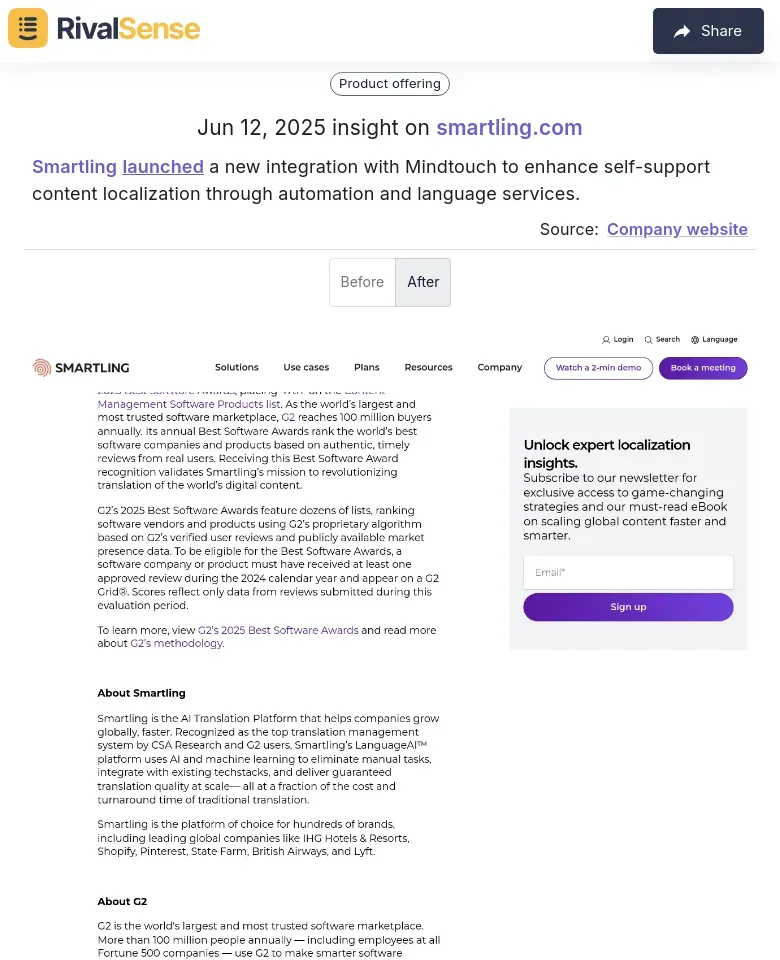How Smartling's Mindtouch Move Spurred Rival Localization Upgrades
Before Smartling's strategic pivot, the localization industry featured a fragmented landscape dominated by players like SDL, Lionbridge, and TransPerfect. These companies relied on traditional translation services with manual processes, struggling to meet growing demands for real-time, scalable solutions. The market was ripe for disruption as businesses increasingly needed efficient ways to localize content for global audiences.
Legacy systems created significant hurdles: slow turnaround times, high costs, and poor CMS integration capabilities. These gaps left opportunities for SaaS-based solutions offering automated localization. Understanding these challenges helps contextualize why Smartling's move was so impactful.
Practical Advice for Competitors:
- ✅ Assess Your Tech Stack: Determine compatibility with modern CMS platforms and automation capabilities
- ✅ Customer Feedback Loop: Regularly collect client insights to identify localization pain points
- ✅ Pilot Agile Solutions: Test small-scale projects with new technologies before full implementation
Smartling's Strategic Move: The Mindtouch Integration
Smartling's integration with Mindtouch marked a pivotal shift toward enhanced localization and content management capabilities. This strategic move combined Mindtouch's knowledge management expertise with Smartling's localization strengths, creating a unified ecosystem for global content strategies. The objectives included streamlining workflows, improving self-service options, and expanding market reach.
Shortly after the acquisition, Smartling launched a new integration to enhance self-support content localization through automation and language services. This exemplifies how tracking product updates provides critical strategic intelligence:

💡 Why this matters: Monitoring such integrations reveals competitors' innovation priorities and technology roadmaps, allowing you to anticipate market shifts and adjust your strategy proactively.
Practical tip: When evaluating competitive moves, analyze how new technologies complement existing offerings and identify integration synergies early.
Competitor Reactions: Upgrades and Innovations
Rivals responded rapidly to Smartling's move, unveiling significant platform enhancements within months. TransPerfect and Lionbridge rolled out AI-driven translation tools and real-time collaboration features, while SDL launched cloud-based updates focusing on scalability. This flurry of activity demonstrated the industry's adaptability while intensifying competitive pressure.
Timeline of key responses:
| Timeframe | Activity |
|---|---|
| Month 1-2 | Market analysis & strategy formulation |
| Month 3-4 | AI/cloud upgrades rollout |
| Month 5-6 | Feature enhancements & customer feedback integration |
Competitor tracking checklist:
- 🔔 Monitor announcements and product updates
- ⏱️ Analyze response timelines to market moves
- 📊 Assess impact on your product strategy
- 🚀 Innovate proactively rather than reactively
Customer Impact: Benefits and Challenges
The competitive upgrades delivered tangible benefits: faster turnaround times, more accurate translations, and AI-driven localization tools. Businesses gained access to innovative features that streamlined global content deployment. However, these transitions presented challenges like interface adaptation, temporary disruptions, and learning curves for new functionalities.
Customer feedback revealed significantly improved satisfaction post-upgrade, particularly regarding support responsiveness and project outcomes. Successful adopters emphasized structured onboarding approaches.
Practical adaptation tips:
- 🧭 Conduct thorough needs assessments before transitioning
- 👥 Request customized onboarding from providers
- 💬 Leverage user communities for peer troubleshooting
Lessons Learned: Strategic Takeaways for Businesses
Smartling's move offers universal lessons for maintaining competitive relevance. First, consistently monitor competitor activities—those who tracked Smartling's integration gained response advantages. Second, leverage competitive intelligence to identify capability gaps in your own offerings. Third, balance swift action with strategic alignment to customer needs.
Actionable steps:
- 🔍 Subscribe to competitor newsletters and update alerts
- 🧩 Conduct quarterly SWOT analyses based on rival moves
- 🗣️ Validate innovation priorities through customer interviews
The localization industry's future will feature increased consolidation and AI adoption. Companies exploring partnerships now will lead the next evolution.
Conclusion: The Ripple Effect of Competitive Moves
Smartling's integration triggered industry-wide innovation, proving that strategic competitor monitoring is essential for market leadership. Businesses that track rivals' product launches and partnerships gain crucial response time to adapt offerings and capture market share. In today's dynamic landscape, agility separates industry leaders from followers.
Proactive monitoring framework:
- 📅 Schedule bi-weekly competitive reviews
- 🤖 Automate tracking with specialized tools
- 🎯 Develop rapid-response playbooks
- 🌱 Foster continuous innovation culture
🔍 Ready to decode competitor moves? Try RivalSense for free and get your first competitor report today. Automate tracking of product launches, pricing changes, and strategic partnerships—transform reactions into proactive strategy.
📚 Read more
👉 How Website Changes Reveal Competitor Talent Strategies
👉 Benchmarking Payment Leaders: Worldline's Market Intelligence Edge
👉 5 Product Offering Mistakes When Tracking Competitor Promotions
👉 The Power of Timely Information: How to Stay Ahead in Business
👉 Decoding Citadel's Commodities Tech Stack Shift: Strategic Implications
